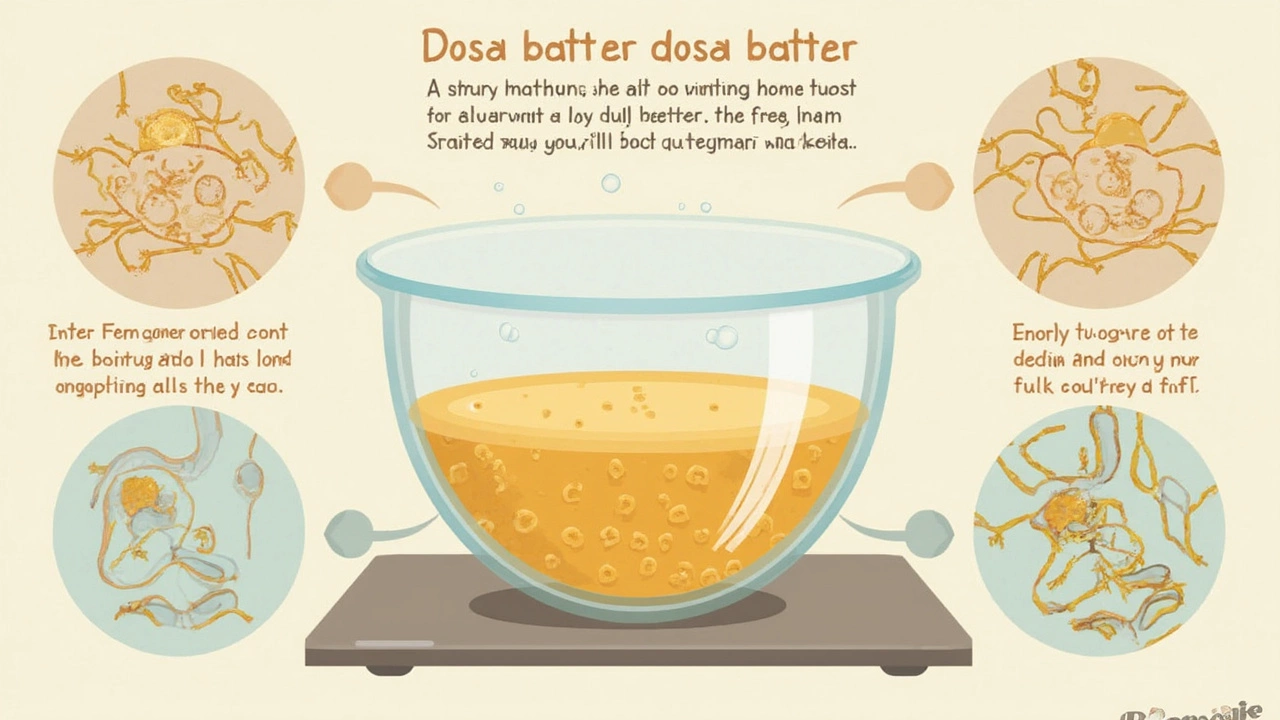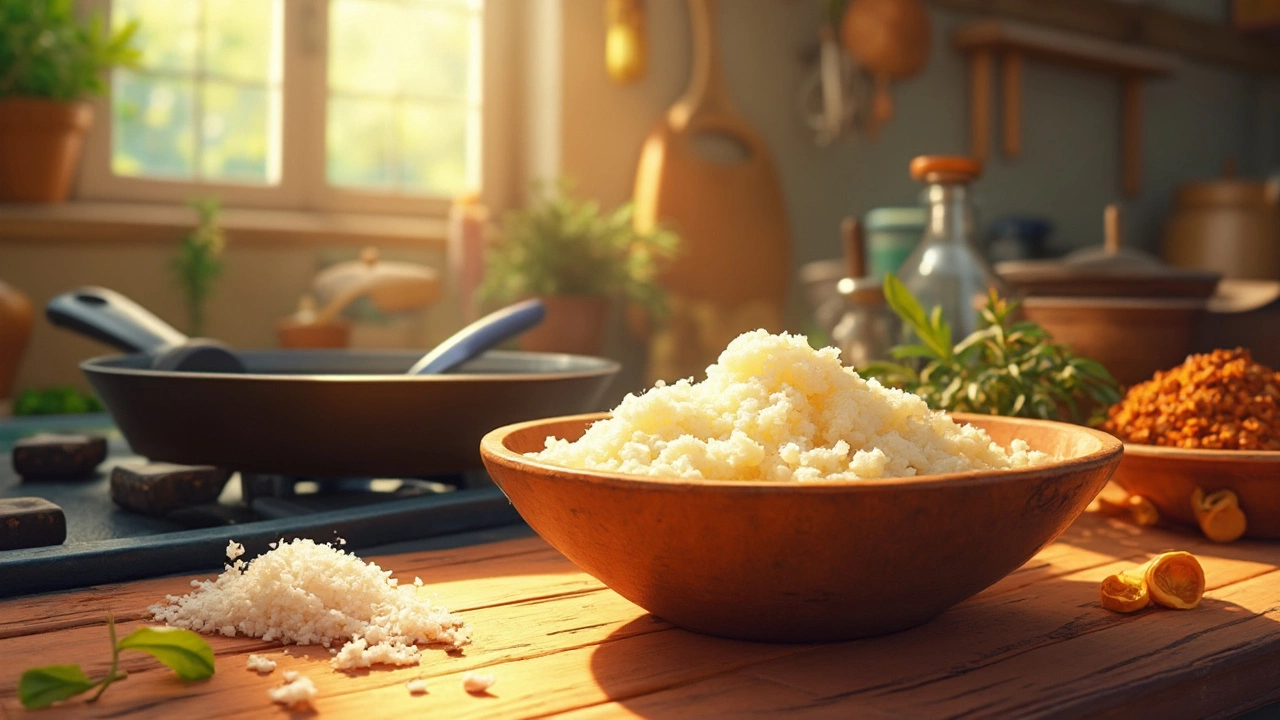27 Mar 2025
- 0 Comments
Ever wonder if adding salt to dosa batter makes a difference in fermentation? You're not alone! While some insist it helps, others believe it can actually slow things down. So, what's the deal with salt and dosa batter?
Fermentation is key to achieving that perfect, tangy flavor and fluffy texture in dosas. It's all about letting natural bacteria and yeast do their thing in the right environment. But where does salt fit into this? Traditionally, salt has been both an ingredient and a preservative, known to inhibit bacterial growth, yet somehow it still finds its way into many recipes.
If you're confused, don't be! We'll break down what actually happens when you add salt and share practical tips so you can whip up the dosa of your dreams—fluffy, crispy, and perfectly fermented. So stay tuned as we dive into the science, and clear up any myths surrounding salt in your dosa batter.
- Understanding Dosa Batter Fermentation
- The Science of Salt in Fermentation
- To Salt or Not to Salt: Expert Opinions
- Practical Tips for Perfect Fermentation
- Common Mistakes and How to Avoid Them
Understanding Dosa Batter Fermentation
To get that perfect dosa, fermentation is crucial. It’s not just about taste; it’s the key to the authentic texture and flavor. The process involves letting natural bacteria and yeast turn the mix of rice and lentils into something magical. This transformation gives us that slightly tangy, delicious batter we love.
Now, why does fermentation work so well with dosa batter? The rice and urad dal (black gram) combo is packed with carbohydrates and proteins that these microorganisms feed on. As they munch away, they produce gas that helps the batter rise and gives dosas their characteristic fluffiness and slight crispness.
Here’s an interesting fact: Temperature plays a huge role. In warmer places, fermentation might happen in just 8 to 12 hours. But if it's cooler, you might need patience and let it sit for up to 24 hours. Some dosa makers even cover their batter with a cloth and place it in a warm spot or an oven with the light on for faster results.
Nina Mehta, a seasoned chef, says, "A well-fermented dosa batter is like fine wine—it needs just the right environment to develop depth and character."
No advanced fermentation equipment needed! Just a little foresight and an eye on the temperature, and you’ll see amazing results. The key here is consistency—whether you’re doing it with or without salt. Speaking of salt, stay tuned, because coming up, we’ll delve into how it factors into your recipe.
The Science of Salt in Fermentation
Alright, let’s dive into the nitty-gritty of how salt affects fermentation in your beloved dosa batter. At its core, fermentation happens when microorganisms break down sugars and starches, usually resulting in carbon dioxide and other goodies that give your dosa its signature fluffiness and tang. You might be surprised, but salt plays a quirky role here.
Salt can affect fermentation in a couple of ways. First off, it strengthens the gluten network. Gluten is that protein that gives the batter its sticky, stretchy texture, and having a strong gluten network means a better trap for all that carbon dioxide. That's a good thing for the bubbles that make your dosa nice and airy.
On the flip side, salt does tend to slow down fermentation slightly. By drawing out water, it can create an environment that's just a little less friendly for some microorganisms, specifically yeast. This slow-down isn’t necessarily a deal breaker, though. It can even be a bonus if you're trying to get a longer, more controlled fermentation, which can lead to a more developed flavor.
This dosa batter recipe puzzle piece all boils down to balance. Too much salt can inhibit the process, leading to flat, uninspiring dosas. But just the right amount can enhance texture and taste.
Here's a fun fact: a widely recommended proportion of salt is about 1.5% of the batter weight. So, if you’re uncertain about how much to use, start there and adjust based on your taste and texture preferences.
Want some more evidence on how much salt affects fermentation rate? Check out this simple table that contrasts different salt concentrations with fermentation time:
| Salt Concentration | Fermentation Time |
|---|---|
| 0% | 4 hours |
| 0.5% | 5 hours |
| 1.5% | 6 hours |
| 3% | 8 hours |
Now that you know the science, you can experiment with your own batter, tweaking the salt to suit your taste while keeping these principles in mind. Happy dosa making!

To Salt or Not to Salt: Expert Opinions
When it comes to dosa batter, the question of whether or not to add salt is a hot topic among seasoned cooks and experts. Some swear by it, while others advise caution.
A popular belief is that adding salt can slow down the fermentation process. The reasoning? Salt tends to draw out moisture, and in high quantities, it might inhibit yeast and bacteria activities. Yet interestingly, many people find that their batter rises just fine—and tastes great—with salt included.
Geeta Devi, a renowned culinary expert from South India, explains, "Salt is often added not just for flavor, but to regulate fermentation. In warmer climates, it can prevent over-fermentation, which might cause sourness.”
“A pinch of salt at the end doesn't hurt, but don't overdo it,” advises Devi convincingly.
Those on the other side of the fence include food scientist, Dr. Ramesh Patel. He claims, "Salt should ideally be added right before cooking. This keeps the batter's texture intact and allows the fermentation to proceed at its natural pace.”
So, what's the takeaway here? Don't stress too much. It's all about finding what works best for your kitchen setup and taste preferences. Here are some practical points:
- If you're in a colder climate, adding salt to the batter initially might slow down what’s already a slow process.
- In tropical areas, it could help control unintended over-fermentation, preventing unwanted taste in your dosa batter.
Remember, experimenting is key. Try both methods and see which you prefer—your taste buds will guide you better than any rule!
Practical Tips for Perfect Fermentation
Making the perfect dosa batter can feel like an art, but with these tips, you'll master it in no time. Ready to dive into action?
First, let's talk about soaking grains. It's essential to use the right ratio of rice to urad dal. Typically, you want about 3 parts rice to 1 part dal. Soak them separately for at least four hours. This step allows them to absorb water evenly, which is key for smooth grinding later.
When it comes to grinding, aim for a smooth yet slightly coarse batter. Grind the dosa batter ingredients separately, then combine them. This lets you control the texture better.
- Temperature Matters: Fermentation thrives in warm environments. If it's chilly, keep the batter in a warm spot like an oven with just the light on.
- Timing is Key: For optimal fermentation, let the batter sit for 8 to 12 hours. Keep an eye on it—the longer it ferments, the tangier it becomes.
- Mix Well: Stir the batter well before fermentation to ensure even distribution of natural yeast.
- Avoid Metal: Use glass or ceramic bowls for fermentation, as metal can react with fermenting agents.
Now about salt—add it after the fermentation process. Why? Because salt can slow down the process. Incorporating salt as the last step ensures that your batter doesn't lose its rise.
Got a busy schedule? You might find this quick guide on room temperature helpful:
| Room Temperature | Fermentation Time |
|---|---|
| Below 20°C | 12-16 hours |
| 20-25°C | 8-12 hours |
| Above 25°C | 6-8 hours |
By following these practical tips, your dosa batter will have just the right texture and flavor. Start your day with perfect dosas every time!

Common Mistakes and How to Avoid Them
Getting the perfect dosa batter for that crispy, delicious dosa isn't rocket science, but a few missteps can make it less than ideal. Here are some common mistakes people make and how you can sidestep them.
1. Skipping the Soaking Time: One big no-no is not soaking your rice and lentils long enough. At least 6-8 hours is ideal to ensure they blend smoothly and ferment properly. If you're in a hurry, you might end up with a gritty batter.
2. Incorrect Fermentation Temperature: Fermentation loves warmth. If your home is too cold, your batter could stay as-is without any fermentation action. Consider placing it in a warm spot, or even in your oven with the light on, to get things going.
3. Adding Salt During Fermentation: Adding salt too early can halt the fermentation process because salt inhibits yeast and bacterial growth. Always add salt just before you make the dosas.
- Dosa Batter Fermentation Temperature Table:
Temperature (°C) Fermentation Time (hrs) 20-22 12-16 25-30 8-10 30-35 6-8
4. Using the Wrong Ratio: Messing up the rice-to-lentil ratio is quite common. Stick to about 3:1 or even 4:1 for a traditional taste. Equal ratios will lead to softer dosas, which can be a bit tricky to crisp up.
5. Inadequate Blending: You want a smooth batter. Using a blender that isn't powerful or blending too short can leave your batter clumpy. Pulse till you get a silky, thick consistency.
By avoiding these pitfalls and giving a bit of love, your dosa batter can make the dosas you've been dreaming of. Remember, small tweaks can lead to big gastronomic rewards!
